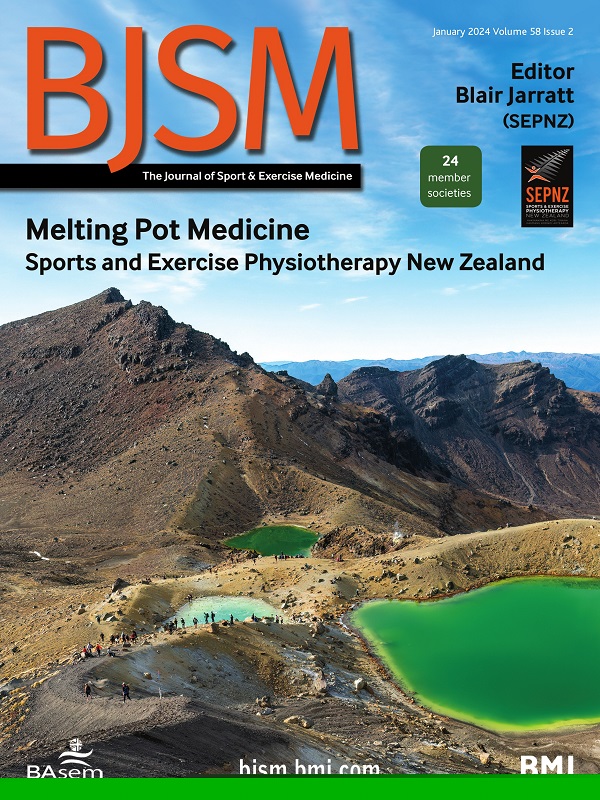心肺功能与不同遗传倾向程度的痴呆症风险之间的关系:一项大型社区纵向研究
IF 11.6
1区 医学
Q1 SPORT SCIENCES
引用次数: 0
摘要
目的 我们旨在研究心肺功能(CRF)与认知功能和痴呆症风险的关系,同时考虑痴呆症的遗传易感性。方法 在英国生物库(UK Biobank)中,对年龄在 39-70 岁之间、未患痴呆症的 61214 名参与者进行了长达 12 年的跟踪调查。通过在固定自行车上进行 6 分钟亚极限运动测试来估算 CRF 分数,并将其分为三等分(即低、中、高;按年龄和性别标准化)。基线时对整体认知功能进行评估。根据病史和医疗记录确定痴呆症患者。使用阿尔茨海默病多基因风险评分(PRSAD)估算痴呆症的遗传易感性,分为低、中、高三个等级。数据采用线性回归、泊松回归和拉普拉斯回归进行分析。结果 与低 CRF 相比,高 CRF 与更好的整体认知功能相关(β=0.05,95% CI 0.04 至 0.07)。在随访期间,有553人患上了痴呆症。与低CRF患者相比,高CRF患者所有痴呆症的发病率比(IRR)为0.60(95% CI 0.48至0.76),高CRF患者与低CRF患者相比,所有痴呆症的发病时间推迟了1.48(95% CI 0.58至2.39)年。在具有中度/高度多基因风险评分的人群中,高CRF可将所有痴呆症的风险降低35%(IRR为0.65,95% CI为0.52至0.83)。结论 高CRF与基线认知表现较好和长期痴呆风险较低有关。高 CRF 可将遗传易感性对痴呆症发病的影响降低 35%。数据可能来自第三方,不对外公开。本文章由计算机程序翻译,如有差异,请以英文原文为准。
Association of cardiorespiratory fitness with dementia risk across different levels of genetic predisposition: a large community-based longitudinal study
Objective We aimed to investigate the association of cardiorespiratory fitness (CRF) with cognitive function and dementia risk, taking genetic predisposition for dementia into account. Methods Within the UK Biobank, 61 214 dementia-free participants aged 39–70 years were followed for up to 12 years. CRF score was estimated using a 6 min submaximal exercise test on a stationary bike and divided into tertiles (ie, low, moderate, and high; standardised by age and sex). Global cognitive function was evaluated at baseline. Dementia was identified based on medical history and medical records. Genetic predisposition for dementia was estimated using the polygenic risk score for Alzheimer’s disease (PRSAD), tertiled as low, moderate, or high. Data were analysed using linear regression, Poisson regression, and Laplace regression. Results Compared with low CRF, high CRF was related to better global cognitive function (β=0.05, 95% CI 0.04 to 0.07). Over the follow-up period, 553 individuals developed dementia. Compared with low CRF, the incidence rate ratio (IRR) of all dementia was 0.60 (95% CI 0.48 to 0.76) for high CRF, and the onset of all dementia was delayed by 1.48 (95% CI 0.58 to 2.39) years among people with high versus low CRF. Among people with a moderate/high polygenic risk score, high CRF attenuated all dementia risk by 35% (IRR 0.65, 95% CI 0.52 to 0.83). Conclusion High CRF is associated with better cognitive performance at baseline, and lower dementia risk long-term. High CRF could mitigate the impact of genetic predisposition on the development of dementia by 35%. Data may be obtained from a third party and are not publicly available.
求助全文
通过发布文献求助,成功后即可免费获取论文全文。
去求助
来源期刊
CiteScore
27.10
自引率
4.90%
发文量
217
审稿时长
3-8 weeks
期刊介绍:
The British Journal of Sports Medicine (BJSM) is a dynamic platform that presents groundbreaking research, thought-provoking reviews, and meaningful discussions on sport and exercise medicine. Our focus encompasses various clinically-relevant aspects such as physiotherapy, physical therapy, and rehabilitation. With an aim to foster innovation, education, and knowledge translation, we strive to bridge the gap between research and practical implementation in the field. Our multi-media approach, including web, print, video, and audio resources, along with our active presence on social media, connects a global community of healthcare professionals dedicated to treating active individuals.

 求助内容:
求助内容: 应助结果提醒方式:
应助结果提醒方式:


